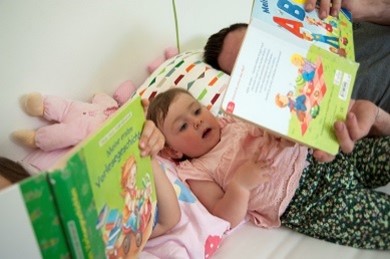Reading to children/reading promotion

Reading to children promotes their development and the bond between parent and child. It has a calming and relaxing effect on many children. Even very young children learn a lot by being read to: It improves both their vocabulary and ability to concentrate. Reading to children also serves as reading promotion. Children who have been read to a lot at an early age find it easier to learn to read and write.
There are many reasons to read to children from an early age – almost all children love it. They enjoy spending time together, can relax and have their imagination stimulated.
Rituals for reading to children
Children love rituals, and reading to them can be easily combined with these: For example, use a cosy corner or bedtime to read a story to your child. Children also love repetition: They often want to be read the same book over and over again.
Learning promotion and memory training
Reading to children regularly can have a very positive impact on their development. The child learns to listen carefully and their vocabulary grows. Reading children the same story repeatedly also trains memory. Children's books cover various topics and provide children with a lot of knowledge in a playful way. Reading to children also promotes language skills, increases intelligence and makes learning to read and write easier later on. Children insert themselves into the figures of a story and thus develop understanding for other people. This makes children more empathetic and promotes social skills and their compassion for others.
Topics in children's books
Children's books often deal with important topics for their age, such as a new sibling, the need for independence or getting used to preschool. Children's books even address challenging topics such as illness or death. This can help children in new or stressful situations.
Tips for reading to children – be creative:
- You can modify the text yourself.
- Talk to your child about what has been read to them or the pictures.
- You can change your voice to distinguish between characters and build tension. This will help you to add variety in the way you present the story.
- Ask about events or develop the story further with your child.
Even more tips:
- You don't necessarily or always have to read to your children. Children love being told stories too. These can be stories from your own childhood. Or you can invent stories in which the same characters appear again and again. Children like this in particular!
- Read to your child in your native or family language. Reading to children promotes language comprehension regardless of the language.
- You don't always have to read to your children yourself – many libraries now also offer activities for young children. Being read to in group situations can be an interesting change for children. This also lets them become familiar with a library while they are young at the same time.
- Books are nice gifts for children. Children often have a favourite book they want to listen to or look at again and again. However, you don't necessarily have to buy books yourself, or new. You can borrow books for any age from libraries. You can also browse through book exchanges or children's flea markets. Many books are free or don't cost much.
You can find more information at the following links:
